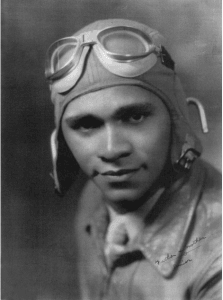2nd Lt Charles Henry DeBow, Jr.
Feb 13, 1918 – April 4, 1968
Class: 42-C-SE
Graduation Date: 3/6/1942
Unit: 99th Fighter Squadron of the 332nd Fighter Group.
Service # 0441130
DeBow also commanded the 301st Fighter Squadron 1943 -1944
When tensions were mounting between the United States and Japan, and as the pressure of joining the war in Europe grew, Charles DeBow wanted to do his part. For him, that meant becoming a pilot, so he went to the Hampton Institute in Virginia to take flying lessons.
Before 1940, African Americans were not permitted to fly for any U.S. military branch. Civil rights movements led to the formation an African American flight squadron based out of Tuskegee, AL.
He eagerly joined the first aviation class with 13 cadets on July 19, 1941, with ground school training in subjects such as meteorology, navigation, and instruments. Successful cadets then transferred to the segregated Tuskegee Army Air Field (TAAF) to complete the Army Air Corps pilot training. The Air Corps provided aircraft, textbooks, flying clothes, parachutes, and mechanic suits, while the Tuskegee Institute provided the facilities for the aircraft and personnel. Lt. Col. Noel F. Parrish served as the base commander from 1942-46.
On March 7, 1942, DeBow was one of the five of the 13 cadets in the first class completed the Army Air Corps pilot training program and earned their silver wings and became the nation’s first black military pilots. The five graduates were second lieutenants Lemuel R. Custis, Charles DeBow, Mac Ross, George Spencer Roberts and Captain Benjamin O. Davis, Jr.

Members of the first graduating class. Left to right: Captain Benjamin O. Davis, Jr., second lieutenants Lemuel R. Custis, George Spencer Roberts , Charles H. DeBow, Mac Ross
In March 1942, Life magazine published an article about the newly incorporated Tuskegee Airmen. For 10 cents, readers could buy the issue that included photos of DeBow.
A sign of the times, the article, in part, read: “White instructors of the 99th agree that their Negro charges, by virtue of exceptional eyesight, courage and coordination, will prove crack combat pilots. Upon their performance and promise hang the hope of additional thousands of aspiring Negro fliers throughout the land.”
DeBow commanded the 301st Fighter Squadron starting in 1943 when it was assigned to Italy and he flew 52 combat missions in the European Theater, including support for D-Day.
The 99th was deployed overseas to fight in the European theater. After 52 missions aboard a P-51 Mustang, Charles DeBow was injured and lost his flight status. When he returned home, and after the war ended, the young lieutenant colonel married and continued his education and eventually worked as a high school teacher and university professor in Indiana.
See the Class Photo and Orders Assigning The First Aviation Cadets To Tuskegee in our Virtual Museum!
Be sure to read “I GOT WINGS” by Charles H. DeBow – An Autobiographical Account of One of the Original Tuskegee Airmen
Sources:
Ventura County Star
Edwards-Moore Family Genealogy Pages
The CAF Red Tail Squadron is a volunteer-driven organization dedicated to educating audiences across the country about the history and legacy of the Tuskegee Airmen, America’s first black military pilots and their support personnel.






